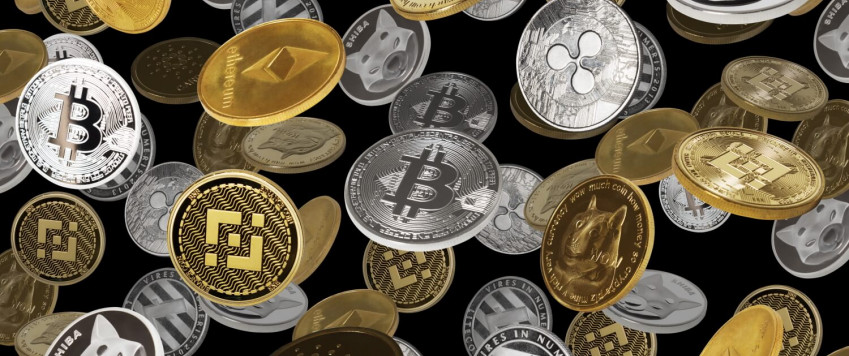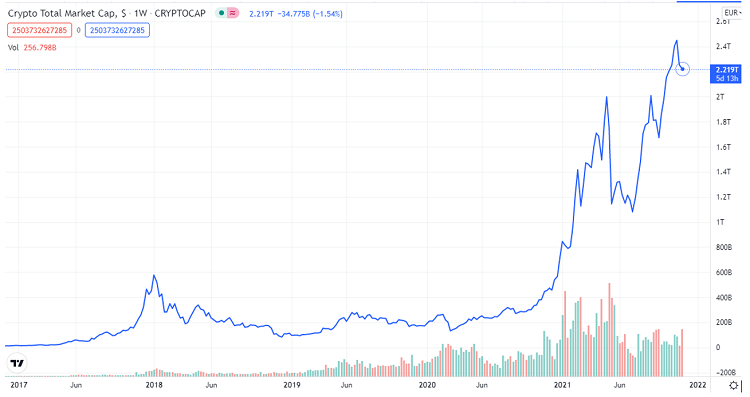Global expansion of crypto-assets, supervision gaining momentum

In short
-
Crypto-assets – digital assets that are based on cryptography and other innovations in information technology, were first introduced more than 10 years ago (2009) and continue strong expansion.
-
Financial market supervisors in Europe, the United States and other countries play catch up: the proposed regulatory framework would treat crypto-assets in the same way as comparable assets in banks.
-
Since mid-2020, the market capitalisation of crypto-assets has been expanding exponentially (almost 2 trillion euro or ~ 280 euro per each person on the planet).
-
Expansion is seen also in the number of crypto assets and there is a potential for usage growth. More widespread usage is found in developing countries to compensate for flaws in their payment systems.
-
In medium developed and developed countries, the interest about crypto-assets is relatively lower. In Latvia, 4% of population have bought crypto-assets.
Crypto-assets are digital assets created and held using cryptography and shared registry technology, but, as defined by the European Central Bank, currently they do not represent a financial claim or liability on any identifiable person . As the crypto world evolves, there will be crypto-assets representing this financial claim, and this definition will need to be adjusted.
In other words, crypto-assets are digital representations of value – the right to a physical or digital asset is created in the form of a digital token. They can significantly reduce the barriers of analogue world that traditional assets such as stocks, bonds, securities, mortgages, mortgage-backed securities, etc., face, namely, physical, geographical and infrastructure interoperability constraints. That being said, the new technology still has to do its homework in the financial world, inter alia dealing with the lack of standardised rules in the crypto-currency business, difficulties in drafting the legal framework and understanding of how to monitor crypto-assets, how to guarantee security. A more detailed discussion on these challenges follows below.
The market capitalisation of crypto-assets has grown exponentially since mid-2020 (reaching around 2 trillion euro in October 2021; see Chart 1), as has the number of crypto-assets. One of the first and best-known is Bitcoin, but its market share has declined over the years from more than 70% at the beginning of 2021 to 45% in October, with other crypto-assets taking up a more important role, including stablecoins .
Chart 1. Capitalisation of crypto-assets (in euro)

Note: measurements: "B" – billion euro, "T" – trillion euro.
The blue line indicates market capitalisation, the bars indicate trade turnover in billions of euro. Green colour indicates a rise in market prices, while red colour indicates a fall in market prices.
Despite an imminent tightening of supervision and competition from central banks' digital currency solutions, it is legitimate to expect further growth in this sector: the use of crypto-assets is on the rise, especially in less developed countries with weak payment systems.
Developing countries stand out in terms of the proportion of population that has purchased crypto-assets, such as Nigeria where crypto-assets have been bought by almost 1/3 of the population. The usage of crypto-assets is lower in medium development countries (e.g. 16% of the population in Turkey and Peru) and low in developed countries (6% in the United States, 5% in Germany and 4% in Japan). In Latvia, 4.0% of the population have purchased crypto-assets, according to a survey conducted by Latvijas Banka and "Latvijas Fakti" in 2021. At the same time, the number of people who have not heard of crypto-assets has declined from 39% in 2018 to 23% in 202.
Market supervisors and legislators are preparing a framework for supervision of crypto-assets
Supervisors such as the Bank for International Settlements (BIS) and the European Securities and Markets Authority (ESMA) are also working on the prudential requirements for financial institutions' investments in crypto-assets. We are very close to having our own regulation of crypto-assets in Europe – a debate has begun in the European Parliament (Markets in Crypto-assets regulation; MiCA).
In June 2021, the BIS launched a public consultation on a proposal to tighten credit and market risk requirements for banks for their investments in crypto-assets (except central bank's digital currencies; see Table 1). The proposal suggests to include crypto-assets in the scope of supervision and to apply at least the same requirements as to other assets of a comparable class held by banks, as well as set capital requirements for invested crypto-assets similar to the most risky asset classes. The BIS encourages the inclusion of crypto-assets in the calculation of leverage, high exposures and liquidity ratios, and in the annual supervisory review and evaluation process (SREP) as well as in the disclosure rules.
Table 1. BIS proposals for credit risk and market risk supervision requirements for bank investments in different crypto-asset classes
|
Tokenised traditional assets |
Crypto-assets with stabilisation mechanism (stablecoins) |
Crypto-assets other than central bank digital currencies (Bitcoin) |
|
Capital requirements at least equivalent to those of traditional assets (with options for capital add-ons) |
New framework built on the existing one to include risks from stabilisation mechanism[1] |
New conservative capital requirements with risk weights of 1250%. |
Given that more and more globally important banks are starting to offer crypto- asset related services or are planning to do so, such guidelines are needed. At the same time, there is a need for stronger requirements in the prevention of money laundering and terrorist financing (AML) and cybercrime for all actors in the financial sector, including unregulated ones, as crime in the digital environment becomes more dangerous, with greater losses for investors.
Read about observations on the prevalence of crypto-assets in Latvia in the next article prepared by the author.
[1] Stabilisation mechanism involves various risks depending on whether it is a direct or indirect issue of a crypto-asset (the issuer transfers the crypto-asset to the customer directly or via an intermediary) and on how its stable value is maintained. There are also risks associated with the asset pool backing the crypto-asset. The riskier the assets in the asset pool, the more complicated it is to guarantee a stable value of the crypto-asset (or a crypto-asset may be backed by a single stable currency or a variable exchange rate currency or currency pool).
Textual error
«… …»






